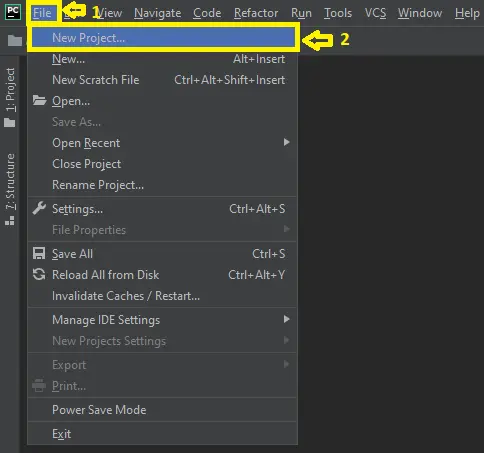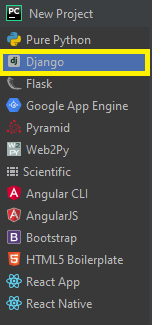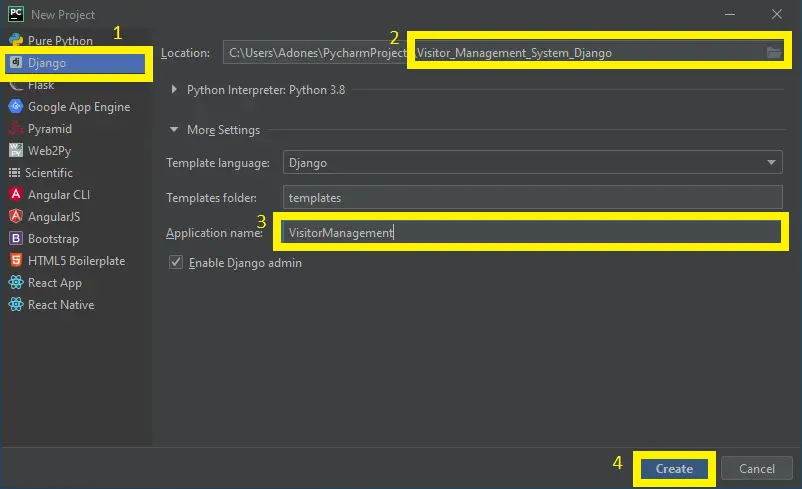The Visitor Management System project in Django is an easy project for beginners to learn how to build a web-based python Django project.
We will provide you with the complete source code and database for the python project so that you can easily install it on your machine and learn how to program in Python Django.
It will keep track of all meetings and send emails and SMS messages to the host and visitors about the specifics of their meeting.
To start creating a Visitor Management System Project in Python Django, makes sure that you have PyCharm Professional IDE Installed in your computer.
This Visitor Management project in Django Framework, Also includes a Download Source Code for free, just find the downloadable source code below and click download now.
Also, you may Checkout the related articles below.
| About Project | Project Details |
|---|---|
| Project Name | Visitor Management System project in Django |
| Python version (Recommended) | 3.8 Version |
| Programming Language Used | Python Django Language |
| Developer Name | itsourcecode.com |
| IDE Tool (Recommended) | Sublime, Visual Studio, PyCharm |
| Project Type | Web Application |
| Database | SQLite |
Admin Features
- Manage Meeting History– For the meeting history, The admin view meeting history information details.
- Add Profile– For the add profile, The admin can add, edit and delete profile information.
- Login – By default the student need to login first to enable to access the system.
- Arrange Meeting– For the arrange meeting, The admin can arrange a meeting for the visitors.
Visitor Management System project Django Steps on How to Create a Project
Time needed: 5 minutes
Here are the steps on how to create a Visitor Management System in Django.
- Step 1: Open file.
First , open “pycharm professional” after that click “file” and click “new project”.

- Step 2: Choose Django.
Next, after click “new project“, choose “Django” and click.

- Step 3: Select file location.
Then, select a file location wherever you want.

- Step 4: Create application name.
After that, name your application.

- Step 5: Click create.
Lastly, finish creating project by clicking “create” button.

- Step 6: Start Coding.
Finally, we will now start adding functionality to our Django Framework by adding some functional codes.
Functionality and Codes of the Visitor Management project in Django
- Create template for the admin login in form.
In this section, we will learn on how create a templates for the admin login form. To begin with, add the following code in your admin_login.html under the folder of accounts/templates/.
{% load static %}
<link
href="//maxcdn.bootstrapcdn.com/bootstrap/4.1.1/css/bootstrap.min.css"
rel="stylesheet"
id="bootstrap-css"
/>
<script src="//maxcdn.bootstrapcdn.com/bootstrap/4.1.1/js/bootstrap.min.js"></script>
<script src="//cdnjs.cloudflare.com/ajax/libs/jquery/3.2.1/jquery.min.js"></script>
<!DOCTYPE html>
<html>
<head>
<title>Admin Login</title>
<link
rel="stylesheet"
href="https://stackpath.bootstrapcdn.com/bootstrap/4.1.3/css/bootstrap.min.css"
integrity="sha384-MCw98/SFnGE8fJT3GXwEOngsV7Zt27NXFoaoApmYm81iuXoPkFOJwJ8ERdknLPMO"
crossorigin="anonymous"
/>
<script src="https://ajax.googleapis.com/ajax/libs/jquery/3.3.1/jquery.min.js"></script>
<link
rel="stylesheet"
href="https://use.fontawesome.com/releases/v5.6.1/css/all.css"
integrity="sha384-gfdkjb5BdAXd+lj+gudLWI+BXq4IuLW5IT+brZEZsLFm++aCMlF1V92rMkPaX4PP"
crossorigin="anonymous"
/>
</head>
<body>
<div class="container h-100">
<div class="d-flex justify-content-center h-100">
<div class="user_card mb-5">
<div class="d-flex justify-content-center">
<div class="brand_logo_container">
<img
src="{% static '/img/admin.jpg' %}"
class="brand_logo"
alt="Logo"
/>
</div>
</div>
<div class="d-flex justify-content-center form_container">
<form action="/admin_login/" method="post">
{% csrf_token %}
<div class="input-group my-3">
<div class="input-group-append">
<span class="input-group-text"
><i class="fas fa-user"></i
></span>
</div>
<input
type="text"
name="username"
class="form-control input_user"
value=""
placeholder="username"
/>
</div>
<div class="input-group my-3">
<div class="input-group-append">
<span class="input-group-text"
><i class="fas fa-key"></i
></span>
</div>
<input
type="password"
name="password"
class="form-control input_pass"
value=""
placeholder="password"
/>
</div>
<div
class="d-flex justify-content-center mt-3 login_container my-5"
>
<button type="submit" name="button" class="btn login_btn">
Login
</button>
</div>
</form>
</div>
</div>
</div>
</div>
</body>
<style>
body,
html {
margin: 0;
padding: 0;
height: 100%;
background: url("{% static '/img/ba.jpg' %}");
background-size: cover;
}
.user_card {
height: 400px;
width: 350px;
margin-top: auto;
margin-bottom: auto;
background: #669900;
opacity: 70px;
position: relative;
display: flex;
justify-content: center;
flex-direction: column;
padding: 10px;
box-shadow: 0 4px 8px 0 rgba(0, 0, 0, 0.2),
0 6px 20px 0 rgba(0, 0, 0, 0.19);
-webkit-box-shadow: 0 4px 8px 0 rgba(0, 0, 0, 0.2),
0 6px 20px 0 rgba(0, 0, 0, 0.19);
-moz-box-shadow: 0 4px 8px 0 rgba(0, 0, 0, 0.2),
0 6px 20px 0 rgba(0, 0, 0, 0.19);
border-radius: 5px;
}
.brand_logo_container {
position: absolute;
height: 170px;
width: 170px;
top: -75px;
border-radius: 50%;
background: #000099;
padding: 10px;
text-align: center;
}
.brand_logo {
height: 150px;
width: 150px;
border-radius: 50%;
border: 2px solid white;
}
.form_container {
margin-top: 100px;
}
.login_btn {
width: 100%;
background: #000099 !important;
color: white !important;
}
.login_btn:focus {
box-shadow: none !important;
outline: 0px !important;
}
.login_container {
padding: 0 2rem;
}
.input-group-text {
background: #000099 !important;
color: white !important;
border: 0 !important;
border-radius: 0.25rem 0 0 0.25rem !important;
}
</style>
</html>
Downloadable Source Code Below.
Anyway, if you want to level up your programming knowledge, especially python, try this new article I’ve made for you Best Python Projects with source code for Beginners.
But If you’re going to focus on web development using Django, you can download here from our list of Best Django Projects with source code based on real-world projects.
How To Run The Visitor System project in Django?
- Step 1: Extract/unzip the file
- Step 2: Go inside the project folder, open cmd and type the following commands to install Django Framework and run the webserver:
- pip install -r requirements.txt
- python manage.py migrate
- python manage.py runserver
- Step 3: Finally, open the browser and go to http://127.0.0.1:8000/
Summary
In summary, this Visitor Management System project in Django with Source Code can be useful to students or professional who wants to learn python programming language.
This project can also be modified to fit your personal requirements. Hope this project will help you to improve your skills. Happy Coding!
Inquiries
If you have any questions or suggestions about Visitor Management System in Django with Source Code, please feel free to leave a comment below.




